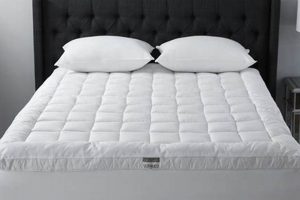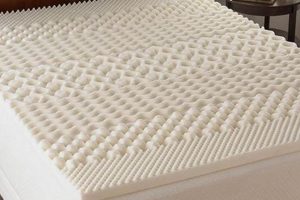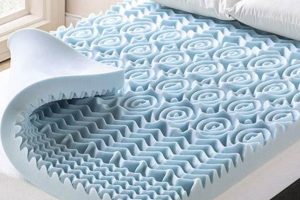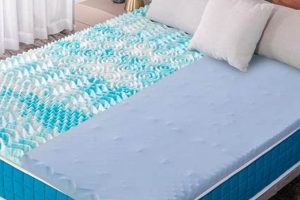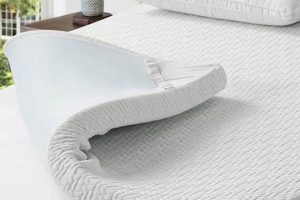This bedding accessory is designed to be placed atop a mattress, aiming to alleviate discomfort associated with sciatic nerve pain. Such products often utilize materials like memory foam or latex, chosen for their contouring and pressure-relieving properties. The goal is to provide a more supportive and comfortable sleep surface for individuals experiencing lower back and leg pain stemming from sciatic nerve compression.
The potential benefits of this type of bedding overlay include improved spinal alignment, reduced pressure points, and enhanced sleep quality. Historically, individuals with sciatica have sought various methods to modify their sleeping environment for increased comfort. This represents a contemporary adaptation, using modern materials and design principles to address a long-standing need for pain management during sleep. Properly selected, a suitable overlay may assist in distributing weight more evenly, thereby minimizing nerve compression and promoting relaxation.
The subsequent sections will explore different types of these supportive overlays, discuss relevant material properties, and provide guidance on selecting an appropriate product based on individual needs and preferences. Key considerations will include density, thickness, material composition, and specific design features intended to address sciatic pain.
Guidance for Selecting a Supportive Bedding Overlay
The following recommendations offer assistance in choosing an appropriate bedding accessory for individuals experiencing sciatic discomfort, focusing on factors that may influence comfort and pain relief.
Tip 1: Prioritize Density. A higher density material, particularly memory foam, generally provides better support and contouring, minimizing pressure points along the sciatic nerve.
Tip 2: Consider Thickness. The thickness of the overlay should be sufficient to provide adequate cushioning. A minimum of 2-3 inches is often recommended for noticeable pressure relief.
Tip 3: Evaluate Material Composition. Memory foam, latex, and gel-infused materials each offer distinct benefits. Consider personal preferences regarding temperature regulation and firmness when making a selection.
Tip 4: Assess Support Zones. Some overlays feature targeted support zones designed to provide additional cushioning to specific areas, such as the hips and lower back.
Tip 5: Investigate Trial Periods and Warranties. Many manufacturers offer trial periods or warranties, allowing consumers to assess the suitability of the product before committing to a purchase.
Tip 6: Consider Professional Guidance. Consulting with a healthcare professional or sleep specialist can provide personalized recommendations based on individual needs and medical history.
Selecting the appropriate bedding overlay can significantly influence sleep quality and comfort for individuals experiencing sciatic pain. Careful consideration of material properties, density, and thickness is crucial.
The subsequent conclusion will summarize the key aspects of the overlay and reiterate its potential role in alleviating sciatic discomfort, emphasizing the importance of informed decision-making.
1. Material Density
Material density, in the context of a bedding overlay designed to alleviate sciatic discomfort, refers to the mass per unit volume of the material used in its construction. Higher density materials, typically employed in memory foam or latex overlays, exhibit a greater capacity to contour to the body’s shape. This conforming characteristic is crucial as it facilitates even weight distribution, thereby minimizing pressure points along the sciatic nerve. For instance, a high-density memory foam overlay responds to body heat and pressure, molding precisely to the lumbar region. This reduces localized stress that might otherwise compress the sciatic nerve and exacerbate pain. Conversely, a low-density material may lack sufficient support, potentially causing the spine to misalign and intensifying sciatic symptoms.
The importance of material density extends beyond immediate comfort. Over time, a higher-density overlay will generally maintain its shape and supportive properties more effectively than a lower-density counterpart. This enhanced durability translates to a longer lifespan and sustained pain relief. An example is the comparison between a 5lb/cubic foot memory foam topper versus a 3lb/cubic foot topper. The 5lb version resists compression and retains its form under sustained use, offering consistent support, whereas the 3lb version may flatten over time, losing its ability to evenly distribute pressure. The selection of an appropriate density is a critical factor in the overall effectiveness of the overlay as a tool for sciatic pain management.
In summary, material density is a foundational element affecting the performance of bedding overlays designed to mitigate sciatic discomfort. The relationship between density and pressure distribution is paramount; a higher density typically equates to improved contouring, enhanced support, and prolonged durability. While other factors, such as material type and thickness, also contribute to the overall effectiveness, a thorough understanding of material density is essential for making an informed selection and maximizing the potential benefits of this therapeutic aid. Challenges in selecting the optimum density exist, as personal preferences for firmness and feel can influence the perceived effectiveness of a given material.
2. Thickness of Overlay
The thickness of a bedding overlay is a significant parameter directly impacting its capacity to mitigate sciatic discomfort. The degree to which an overlay’s thickness can effectively reduce pressure on the sciatic nerve and improve spinal alignment is closely tied to its potential to provide relief. Insufficient thickness may render the overlay ineffective, while excessive thickness may create an unstable sleep surface.
- Pressure Redistribution Effectiveness
The primary function of an appropriately thick overlay is to redistribute body weight, minimizing concentrated pressure on sensitive areas that may impinge upon the sciatic nerve. A thinner overlay, perhaps less than two inches, may compress fully under body weight, failing to provide adequate cushioning and pressure relief. Conversely, a thicker overlay, ranging from three to four inches, generally provides a greater capacity for pressure absorption and redistribution. Examples include overlays made of viscoelastic foam, where increased thickness corresponds to a more substantial reduction in peak pressure points.
- Spinal Alignment Support
Thickness influences the ability of the overlay to maintain proper spinal alignment. The overlay must conform to the body’s contours without allowing excessive sinking or creating unnatural spinal curv
ature. Insufficient thickness may result in the sleeper sinking too deeply into the mattress, negating the overlay’s potential to promote alignment. Overly thick overlays can also contribute to spinal misalignment, especially for individuals with softer mattresses, as they may introduce an unstable surface plane. An ideal thickness provides sufficient support to maintain the spine’s natural curvature while accommodating individual body shapes and weights. - Material Density and Durability
The relationship between thickness and material density is crucial. A thinner overlay constructed from high-density material may offer greater support and durability than a thicker overlay made from lower-density materials. For example, a two-inch high-density latex overlay can provide comparable support to a three-inch low-density memory foam overlay. The thickness must be considered in conjunction with the material’s density and resilience to ensure long-term effectiveness and prevent premature degradation of support. Moreover, the construction quality and layered composition also matter.
- Temperature Regulation Considerations
The thickness of an overlay can influence its thermal properties. Thicker overlays, particularly those made from memory foam, may retain more heat, potentially leading to discomfort for some individuals. Conversely, thinner overlays, or those incorporating cooling technologies such as gel infusions or open-cell structures, may promote better airflow and reduce heat retention. Consideration of individual temperature preferences and the overlay’s thermal characteristics is essential for ensuring a comfortable sleep environment.
The thickness of a bedding overlay, in conjunction with its material composition and density, plays a vital role in mitigating sciatic discomfort by promoting proper spinal alignment, redistributing pressure, and influencing temperature regulation. Effective use relies on a holistic consideration of individual needs and preferences, combined with careful evaluation of the overlay’s specific properties.
3. Spinal Alignment
Proper spinal alignment is a critical factor in managing sciatic discomfort and optimizing sleep quality. A bedding overlay designed to alleviate sciatica symptoms directly influences spinal posture during sleep, potentially mitigating nerve compression and related pain. The effectiveness of such an overlay is contingent upon its ability to support the natural curvature of the spine.
- Contouring and Support
The overlay’s material and design must conform to the sleeper’s body contours while providing adequate support to prevent sinking or misalignment. For example, an overlay with zoned support may offer firmer cushioning under the lumbar region and softer support under the shoulders, promoting a neutral spinal position. The overlay should counteract gravitational forces that may otherwise exacerbate spinal curvature, particularly in side-sleeping positions.
- Pressure Redistribution
Spinal alignment is intrinsically linked to pressure distribution. A misaligned spine can concentrate pressure on specific points, potentially impinging on the sciatic nerve. A properly aligned spine, facilitated by a supportive overlay, distributes weight more evenly across the body, reducing localized pressure and minimizing nerve compression. Examples include overlays designed with specialized channels or cutouts to relieve pressure on the sacrum and hips, promoting both spinal alignment and pressure relief.
- Consistency Across Sleep Positions
Effective spinal alignment support should be maintained regardless of the sleeper’s position. An overlay may provide excellent support in the supine position but fail to maintain proper alignment in the lateral position, or vice versa. The overlay’s design and material properties must accommodate various sleep positions to ensure consistent spinal support throughout the night. This is particularly important for individuals who tend to shift positions frequently during sleep.
- Long-Term Spinal Health
Sustained periods of poor spinal alignment during sleep can contribute to chronic pain and musculoskeletal issues. A supportive bedding overlay, when used consistently, may help prevent the development of such problems by promoting proper posture and reducing strain on spinal structures. Examples of long-term benefits may include reduced muscle tension, improved circulation, and decreased risk of degenerative disc disease.
The aforementioned elements underscore the intricate relationship between spinal alignment and bedding overlays intended to alleviate sciatic discomfort. These supportive overlays provide a means to promote optimal spinal posture, thereby reducing the potential for nerve compression and associated pain. Careful selection of an overlay based on individual needs and preferences is essential for maximizing these potential benefits. Furthermore, consulting with a healthcare professional can provide personalized recommendations to ensure appropriate alignment and support.
4. Pressure Distribution
The distribution of pressure exerted by the body against a sleep surface directly influences sciatic nerve irritation. Bedding overlays designed to alleviate sciatica symptoms aim to equalize this pressure, mitigating concentrated force on areas susceptible to nerve compression. Efficient pressure distribution is paramount for realizing therapeutic benefits.
- Surface Conformity
The extent to which a bedding overlay conforms to the body’s contours dictates its ability to redistribute pressure. Materials such as memory foam or latex are selected for their capacity to mold to the body, creating a more uniform contact surface. This conformity minimizes areas of high pressure that could aggravate the sciatic nerve. In contrast, a rigid surface concentrates pressure on bony prominences, potentially exacerbating discomfort. For example, an overlay that effectively cradles the hips and shoulders will redistribute weight more evenly compared to a flat surface.
- Zonal Support
Certain bedding overlays incorporate zonal support systems, featuring varying degrees of firmness across different areas. These zones are strategically placed to provide targeted support to specific body regions. For example, a firmer zone beneath the lumbar region promotes spinal alignment, while a softer zone under the shoulders accommodates the natural curvature of the body. This differential support contributes to balanced pressure distribution and reduces stress on the sciatic nerve. An overlay lacking zonal support may fail to address the unique pressure points associated with individual body shapes and sleeping positions.
- Material Density and Compression
The density of the overlay material influences its capacity to resist compression under load. Higher-density materials retain their shape and supportive properties for a longer duration, providing consistent pressure distribution over time. Low-density materials may compress prematurely, losing their ability to redistribute pressure effectively. For instance, a high-density memory foam overlay will exhibit less compression under sustained pressure compared to a low-density counterpart, maintaining a more uniform weight distribution th
roughout the night. - Influence of Sleeping Position
Pressure distribution requirements vary according to sleeping position. Side sleeping typically concentrates pressure on the hips and shoulders, while back sleeping distributes weight more evenly across the body. A versatile bedding overlay should adapt to these varying pressure profiles, providing adequate support and redistribution regardless of sleeping position. An overlay designed specifically for back sleepers may not provide sufficient relief for side sleepers, underscoring the importance of considering individual sleep preferences when selecting an appropriate product.
The interplay between surface conformity, zonal support, material density, and sleeping position determines the overall effectiveness of a bedding overlay in facilitating pressure distribution. By optimizing these factors, such products aim to alleviate pressure on the sciatic nerve, contributing to reduced pain and improved sleep quality.
5. Pain Alleviation
Effective pain alleviation is the primary objective for individuals seeking solutions for sciatic discomfort. A bedding overlay designed to address sciatica-related pain operates by modifying the sleep surface to reduce pressure on the sciatic nerve and promote proper spinal alignment. The direct correlation lies in the overlay’s material composition and structural design, which aim to minimize the factors contributing to nerve compression and inflammation. For instance, an individual experiencing sciatic pain may find that their existing mattress exacerbates their symptoms due to inadequate support and uneven pressure distribution. Implementation of a memory foam overlay, designed to contour to the body and distribute weight more evenly, can reduce localized pressure on the sciatic nerve, leading to a measurable reduction in pain intensity.
The effectiveness of an overlay in achieving pain alleviation is contingent upon several variables, including the severity of the individual’s sciatica, the specific type of overlay utilized, and the individual’s overall health and lifestyle. An overlay with targeted support zones, for example, can provide additional cushioning to the lumbar region and hips, areas often implicated in sciatic nerve impingement. Furthermore, consistent use of the overlay, combined with other conservative treatments such as physical therapy and medication, can enhance the likelihood of achieving sustained pain relief. Practical application involves carefully selecting an overlay based on individual needs and preferences, considering factors such as material density, thickness, and overall firmness. This is a long-term solution that needs care to keep it to provide comfort to the user.
In summary, pain alleviation is the central motivation for utilizing bedding overlays designed for individuals with sciatica. Achieving this goal requires a multifaceted approach, involving careful consideration of overlay properties, individual health factors, and adherence to a comprehensive treatment plan. While an overlay alone may not completely eliminate sciatic pain, it can serve as a valuable component of a broader strategy aimed at improving sleep quality and reducing nerve compression. Further research and development in overlay design may lead to even more effective solutions for alleviating sciatic discomfort and enhancing overall well-being, as an understanding to user feedback is very important.
6. Support Firmness
Support firmness, within the context of a bedding overlay intended to alleviate sciatic discomfort, denotes the degree of resistance offered by the material to compression. The appropriate level of firmness directly influences spinal alignment and pressure distribution, key determinants in managing sciatic nerve irritation. Insufficient support firmness may lead to spinal misalignment and concentrated pressure on the hips and lower back, potentially exacerbating sciatic symptoms. Conversely, excessive firmness may fail to conform to the body’s contours, negating pressure relief benefits. An example would be the comparison of two “sciatica mattress topper” options: one with a soft, plush surface that allows the spine to sink into an unnatural position, and another with a medium-firm structure that provides adequate resistance, maintaining the spine’s natural curvature. The latter is more likely to reduce nerve compression and subsequent pain.
The optimal support firmness is subjective and dependent on individual factors such as body weight, sleeping position, and personal preference. Heavier individuals generally require a firmer support to prevent excessive sinking, while lighter individuals may find a softer surface more comfortable. Side sleepers typically benefit from a surface that allows the shoulder and hip to sink slightly, maintaining spinal alignment, whereas back sleepers often require a more uniformly firm surface. The practical significance lies in carefully evaluating these individual needs when selecting a “sciatica mattress topper”. A trial period, where available, allows for objective assessment of support firmness and its impact on sciatic symptoms. Furthermore, consulting with a healthcare professional or sleep specialist can provide tailored recommendations based on individual circumstances.
In summary, support firmness is a crucial component of a “sciatica mattress topper,” directly impacting its effectiveness in alleviating sciatic discomfort. The ideal firmness level is highly individualized, necessitating careful consideration of body weight, sleeping position, and personal preferences. Achieving optimal spinal alignment and pressure distribution relies on selecting a “sciatica mattress topper” with the appropriate level of support firmness. Challenges arise in objectively assessing firmness levels, highlighting the importance of trial periods and expert guidance. Correct firmness provides comfort for the patient and it help spinal problems to be gone over time.
7. Sleep Quality
Sleep quality, defined by factors such as sleep duration, sleep latency, sleep efficiency, and subjective sleep satisfaction, holds significant relevance for individuals experiencing sciatica. Reduced sleep quality can exacerbate pain perception, impede physical recovery, and negatively impact mental well-being, potentially creating a feedback loop wherein sciatic pain disrupts sleep, and compromised sleep amplifies pain sensations. The selection and utilization of a supportive bedding overlay designed to mitigate sciatic discomfort, is a crucial consideration in addressing these challenges.
- Pain Interference and Sleep Disruption
Sciatica-related pain frequently interferes with the ability to fall asleep and stay asleep, leading to fragmented sleep patterns and reduced overall sleep duration. The resulting sleep deprivation can lower an individual’s pain threshold, making them more sensitive to nociceptive stimuli. For instance, a person experiencing acute sciatica may toss and turn throughout the night in search of a comfortable position, resulting in frequent awakenings and a significant decrease in sleep efficiency. A bedding overlay that effectively reduces pressure on the sciatic nerve can minimize nocturnal pain episodes and prom
ote more consolidated sleep. - Spinal Alignment and Sleep Architecture
Poor spinal alignment during sleep can contribute to muscle tension, nerve compression, and increased pain intensity, disrupting normal sleep architecture. The restorative stages of sleep, particularly slow-wave sleep, are essential for physical recovery and pain modulation. Spinal misalignment can impede the attainment of these deep sleep stages, hindering the body’s natural healing processes. A properly designed bedding overlay can support the spine’s natural curvature, promoting optimal alignment and facilitating the transition into deeper, more restorative sleep cycles.
- Psychological Impact and Sleep Satisfaction
Chronic pain, including sciatica, can significantly impact psychological well-being, leading to anxiety, depression, and increased stress levels. These psychological factors, in turn, can further disrupt sleep, creating a vicious cycle. Subjective sleep satisfaction, a measure of an individual’s perceived quality of sleep, is often reduced in individuals with chronic pain. A bedding overlay that effectively alleviates pain and promotes physical comfort can improve subjective sleep satisfaction, contributing to a more positive psychological state and enhancing overall sleep quality.
- Inflammation and Sleep Regulation
Inflammation plays a significant role in both sciatica and sleep regulation. Inflammatory cytokines, such as interleukin-6 and tumor necrosis factor-alpha, are involved in both pain signaling and sleep-wake regulation. Disrupted sleep can exacerbate inflammation, potentially worsening sciatic symptoms. A bedding overlay that promotes comfortable and uninterrupted sleep may help regulate inflammatory processes, contributing to reduced pain and improved sleep quality. Moreover, certain overlay materials, such as those infused with cooling gels, can help regulate body temperature during sleep, further promoting comfort and reducing inflammation.
In summation, sleep quality is inextricably linked to sciatic pain. The appropriate use of a specially designed bedding overlay to support spinal alignment, reduce pressure points, and promote a comfortable sleep environment is an effective strategy to counter this cycle of pain and poor sleep. This is because the key points include a consistent routine, and a comfortable temperature.
Frequently Asked Questions About Bedding Overlays for Sciatic Discomfort
The following addresses common inquiries regarding the selection and utilization of a supportive bedding overlay for alleviating discomfort associated with sciatic nerve compression.
Question 1: What distinguishes a bedding overlay designed for sciatica from a standard mattress topper?
Products marketed for sciatica often incorporate specific design features, such as zoned support or specialized materials, intended to address pressure points and promote spinal alignment. Standard mattress toppers may lack these targeted features.
Question 2: How does the density of the overlay material influence its effectiveness in alleviating sciatic pain?
Higher-density materials, particularly memory foam, generally offer greater support and contouring, distributing weight more evenly and reducing pressure on the sciatic nerve. Lower-density materials may compress prematurely, diminishing their supportive capabilities.
Question 3: Can a bedding overlay completely eliminate sciatic pain?
While a supportive bedding overlay can contribute to pain reduction, it is unlikely to eliminate sciatic pain entirely. It is often most effective when used in conjunction with other conservative treatments, such as physical therapy or medication.
Question 4: How does the thickness of a bedding overlay impact spinal alignment?
Sufficient thickness is necessary to provide adequate cushioning and support, preventing the sleeper from sinking too deeply into the mattress. Overly thick overlays, however, can create an unstable sleep surface, potentially compromising spinal alignment. An appropriate thickness balances support and conformity.
Question 5: Are all materials equally effective for alleviating sciatic discomfort?
Different materials offer varying degrees of support, pressure relief, and temperature regulation. Memory foam, latex, and gel-infused materials each possess unique properties that may be suitable for different individuals. Personal preference and specific needs should guide material selection.
Question 6: How long does it typically take to experience the benefits of a bedding overlay for sciatica?
The time frame for experiencing noticeable benefits can vary depending on individual factors, such as the severity of the sciatica and the specific properties of the overlay. Some individuals may experience immediate relief, while others may require several weeks to fully adapt to the new sleep surface.
The selection of an appropriate bedding overlay necessitates careful consideration of individual needs, material properties, and design features. Consulting with a healthcare professional is advisable for personalized recommendations.
The following section will address the topic of maintaining and caring for a bedding overlay to ensure its longevity and effectiveness.
Conclusion
This exploration has underscored the multifaceted nature of the “sciatica mattress topper” as a tool for mitigating sciatic discomfort. Key considerations include material density, overlay thickness, and their combined impact on spinal alignment and pressure distribution. Individualized needs and preferences must guide the selection process to maximize potential therapeutic benefits. The integration of a “sciatica mattress topper” into a comprehensive pain management strategy holds promise for improving sleep quality and overall well-being.
Ultimately, informed decision-making is paramount. While a “sciatica mattress topper” offers a non-invasive means of potentially alleviating symptoms, its effectiveness is not guaranteed and should be viewed as one component of a holistic approach to managing sciatic pain. Further research and refinement of “sciatica mattress topper” designs may yield even more effective solutions in the future, underscoring the ongoing importance of evidence-based practices in addressing this prevalent condition.



